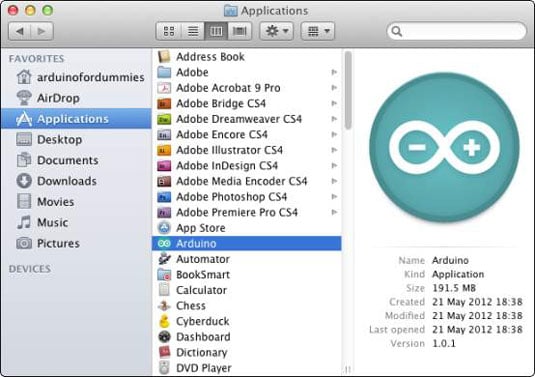

- OLD VERSTIONS OF ARDUINO FOR MAC HOW TO
- OLD VERSTIONS OF ARDUINO FOR MAC MAC OSX
- OLD VERSTIONS OF ARDUINO FOR MAC INSTALL
- OLD VERSTIONS OF ARDUINO FOR MAC SERIAL
So we write (or use someone else’s) code, as a “sketch” for a particular task, and we upload it into one or more microcontrollers in the different remote nodes. It’s a good idea to think about how you name stuff and where you put it, because you’ll want to find it again whenever you fire up the IDE. So an essential part of the IDE is to help you manage all those different tasks and versions used for different microcontrollers in your (usually growing) collection of remote sensor nodes. Note that there is no way back: you can’t get code out of a microcontroller and turn it into the source text you wrote. Then the whole process kicks in again – we load the sketch we were working on back into the IDE, make the changes, compile, upload, try things out, and again: once it works, the IDE can be closed and left alone. In day-to-day use, the IDE plays no role – until we decide to make changes, add new features, extend the code… or fix bugs.
OLD VERSTIONS OF ARDUINO FOR MAC HOW TO
The IDE also defines various conventions for how and where to store different pieces of software if we have more than one microcontroller, how to deal with standard libraries obtained from other software developers, and which type of microcontrollers we can handle through this environment.Īll of this is essential during development, but once the compiled code has been stored in the microcontroller, it’s not really needed anymore. If your background is PHP or Python, you may want to read a bit more about compiled languages.
OLD VERSTIONS OF ARDUINO FOR MAC SERIAL
The Arduino IDE is an editor, a compiler (translating the program source text into some obscure binary code which one particular type of microcontroller understands), an uploader, and a serial terminal interface – all rolled into one app. The “Integrated Development Environment” is where we create the software that ends up running on our microcontroller(s) – be it an Arduino, a JeeNode (which can be used just like an Arduino Uno because it has the same ATmega328 microcontroller), an RBBB, or a range of other similar products. What is an IDE?īut, wait… what is this thing? And why do we need it?

Ĭongratulations, you’ve installed a fairly large package and it’s all running as expected. If you click on the leftmost round button, the one with the checkmark, then the bottom part of the window should also show that same text: Binary sketch size. If all went well, you should be able to launch the IDE and see something like this after you open the LED blink example sketch with File > Examples > 1.Basics > Blink.

Should take no more than 15 minutes, normally.
OLD VERSTIONS OF ARDUINO FOR MAC MAC OSX
Note that you don’t have to follow all the steps (1.7 on Windows and Mac OSX are enough), because we’re not going to connect any hardware or upload any software just yet. The recommended version is Arduino IDE 1.0.3, at the moment. This process is fully described on the Getting Started with Arduino page.

Installing the IDEĪs a first step, we need to perform that installation. Now they are free, open source, extensively documented, and surrounded by a vibrant community.
OLD VERSTIONS OF ARDUINO FOR MAC INSTALL
The success of the Arduino is partly due to the fact that these tools have become easy to install and use.īefore the Arduino era, cross compilers were complex, platform-specific, and too expensive for personal use in small projects. The Arduino has brought this approach to the masses, by providing an open-source IDE to develop, compile, upload, and run the software in the form of embedded software (called “sketches” in Arduino-speak). To get that code onto these devices, we need to cross compile the software on our (big) computer running Windows, Mac OSX, or Linux, and then upload it into the permanent memory of a microcontroller chip. Let’s get going!ĭIJN differs from a conventional laptop / workstation setup, in that it will be interfacing to the real world via microntrollers running our code. Welcome to the second instalment of Dive Into JeeNodes.


 0 kommentar(er)
0 kommentar(er)
